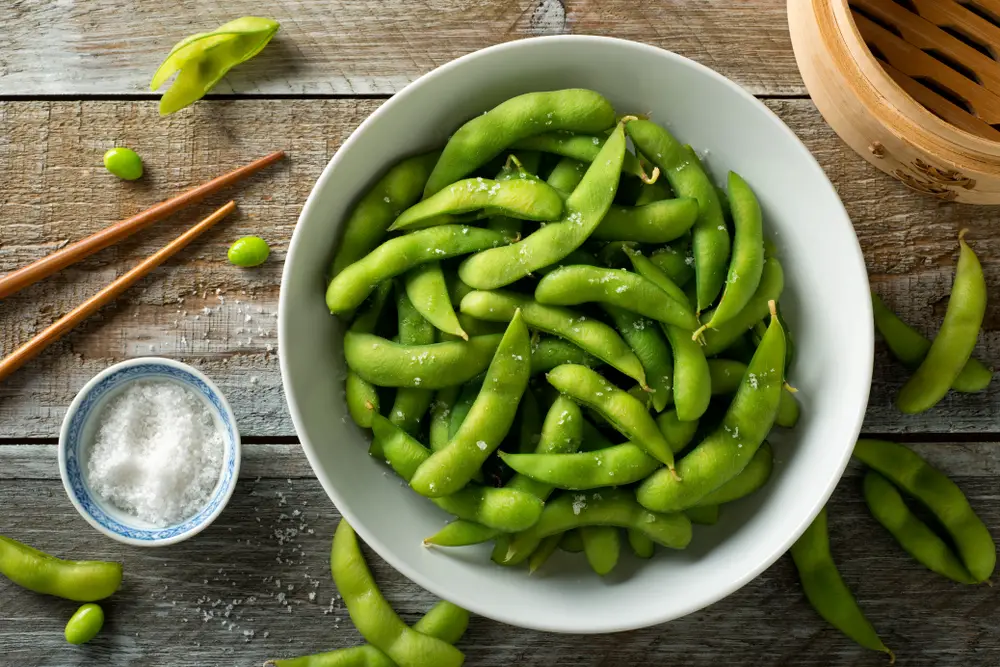Edamame and soybeans, both derived from the same plant species, are popular legumes often found in various dishes across the globe. Despite sharing a common origin, these two variations possess distinct characteristics and nutritional profiles that set them apart in terms of usage and health benefits.
Understanding the differences between them can help individuals make informed decisions when incorporating these versatile beans into their diets.
The key distinction between edamame and soybeans lies in their stages of maturity. Edamame is the immature form of the bean, harvested when it is still green and often consumed fresh in an array of dishes or as a snack.
In contrast, soybeans are the mature, dried seeds that are typically used to produce a wide range of food products such as tofu, tempeh, and soy milk, owing to their dense nutritional composition.
Soybeans boast a higher concentration of calories, protein, and fats compared to edamame, which contains more net carbs while being richer in dietary fibre.
Additionally, both beans are excellent sources of plant-based proteins and several essential nutrients. Consequently, the choice between edamame and soybeans often depends on individual taste preferences, nutritional needs, and dietary requirements.
Understanding Edamame and Soybeans
Edamame and soybeans both belong to the legume family and are part of the same plant species, scientifically known as Glycine max. The key difference lies in their level of maturity: while edamame is the immature soybean harvested when still green and encased in its pod, soybeans are the matured seeds of the same plant.
Edamame is often served fresh, boiled or steamed and is usually in their green pod form. These tender, green seeds make a nutritious snack, main course vegetable or a side dish. On the other hand, mature soybeans are denser in nutrients and primarily used for producing versatile products, such as soy milk, tofu, and soy protein.
In terms of nutritional content, soybeans are higher in calories, protein, and fats as compared to their earlier stage counterparts, edamame. However, edamame contains more net carbs while soybeans are richer in dietary fibre. Both of them are incredibly nutritious; it would be difficult to declare one as superior to the other.
From an agricultural standpoint, Glycine max is a vital crop. Mature soybeans, when processed, make up a considerable portion of the world’s cooking oil and animal feed. Moreover, its high protein content makes it a valuable option for people looking to adopt plant-based diets. Conversely, edamame serves more as a tasty and nutrient-rich snack or ingredient in everyday cooking.
In conclusion, edamame and soybeans showcase the adaptability and diversity of the legume family. Although they originate from the same plant, their varied levels of maturity contribute to the differences in nutritional values, textures, flavours, and culinary uses. So, whether it is green, plump pods or denser, nutrient-rich seeds, both edamame and soybeans offer plenty of benefits and possibilities in the kitchen and beyond.
The Nutrition Profile
Protein Content
Edamame and soybeans both contain significant amounts of protein, but soybeans have a slightly higher protein content. A 100g serving of soybeans provides 18.2g of protein, while the same serving of edamame beans contains 12g of protein 1. Both beans contain essential amino acids, which are necessary for the body’s growth and repair 1.
Vitamin and Mineral Content
Both edamame and soybeans are rich in vitamins and minerals. Edamame is a good source of iron, calcium, magnesium, and vitamin K. Soybeans also contain a variety of minerals, including iron, calcium, and magnesium, as well as vitamin K, folate, and vitamin C.
Fibre and Carbohydrates
Edamame is lower in carbohydrates when compared to soybeans and many other legumes. One cup of shelled, steamed edamame contains nearly 14 grams of carbohydrates, compared to 40 grams of carbohydrates for a cup of cooked lentils or kidney beans and 45 grams for a cup of boiled garbanzo beans. Both edamame and soybeans are an excellent source of dietary fibre, which aids in digestion and helps maintain a healthy gut.
Fat Content
When comparing the fat content in edamame and soybeans, soybeans contain a higher amount of fat per 100g serving. However, it is essential to note that most fats in soybeans are healthy unsaturated fats, which are beneficial for heart health. This also means they have a lower percentage of saturated fats, which can contribute to increased levels of cholesterol.
In conclusion, both edamame and soybeans offer a range of nutrients, including protein, fibre, and essential vitamins and minerals. They each hold their own unique benefits and can be included in a balanced diet to contribute to overall health and wellbeing.
Consumption and Use Worldwide
Edamame and soybeans are both derived from the same plant, Glycine max (L.) Merr. While edamame is the young, green soybeans harvested before they mature, soybeans are the mature, dried version of the same plant. Their consumption and uses vary significantly across the world, predominantly in East Asia and Western countries.
In East Asia, particularly Japan, edamame is a popular snack and side dish. It is usually prepared by boiling or steaming the pods and then sprinkling them with salt. They are typically served as an appetizer in Japanese restaurants and enjoyed as a healthy, protein-rich alternative to other snacks. Edamame is not limited to Japan; it has gained popularity in other East Asian nations and even Western countries like the USA, where its consumption has increased significantly over the last 20 years.
On the other hand, soybeans form a significant component of many Asian cuisines, with numerous uses in various dishes. Common examples include tofu, soy sauce, soy milk, and tempeh. Tofu is a versatile and widely consumed product in both vegan and vegetarian diets. Similarly, soy milk serves as a common dairy-free alternative, particularly for those who are lactose intolerant or choose not to consume animal-derived milk products.
Soy sauce, a staple condiment in East Asian cooking, is produced by fermenting soybeans with salt and other ingredients, resulting in a rich, savoury flavour. Tempeh, originating in Indonesia, is made through a fermentation process that binds soybeans into a cake-like form, making it a popular high-protein food source for vegans and vegetarians.
Though soybeans originated in Asia, their production has become extensive in other parts of the world, particularly the USA and Brazil, which together account for around 69% of global soy production. Most of this output is used for animal feed, with around 77% of soy production being directed towards this purpose.
Interestingly, the use of soybeans in Western recipes has also seen a rise, as more people incorporate soy-based products into their diets for various health and ethical reasons. As the demand for plant-based protein sources grows, the consumption of edamame, tofu, and other soy-derived products is likely to continue increasing worldwide, showcasing the versatile nature of this humble legume.
Health Benefits and Risks
Benefits
Edamame, as well as soybeans, are known for their numerous health benefits. They both contain essential nutrients and are an excellent source of protein. Edamame provides 18.2 grams of protein per 100 grams, which meets 36% of the daily value. Soybeans, on the other hand, are higher in calories, protein, and fats, and are denser in nutrients overall.
These nutritious legumes are rich in isoflavones, which have been shown to play a role in preventing certain types of cancer. Moreover, they contain antioxidants that help protect the cells from damage caused by free radicals, promoting overall health.
Consuming edamame and soybeans can also promote heart health since they have been linked to lower cholesterol levels. Particularly, these legumes have shown significant effects on reducing ‘bad’ LDL cholesterol, which poses the greatest risk to your heart. Regular soy consumption is also associated with a reduced risk of heart disease.
In terms of maintaining bone health, both edamame and soybeans provide essential nutrients, such as calcium and magnesium, that can help prevent osteoporosis. These nutrients contribute to building and maintaining strong bones.
Potential Risks
While edamame and soybeans offer numerous health benefits, there are some potential risks to be aware of. Individuals with soy allergies should avoid consuming these legumes, as they may cause allergic reactions. It is also important to note that some people may experience digestive discomfort when consuming high amounts of soy products, as they contain compounds called oligosaccharides that may cause gas or bloating.
Some studies have also raised concerns about the high levels of isoflavones in soy products, which mimic estrogen in the body. These phytoestrogens can potentially interfere with hormone function, especially in women. However, research on this topic is inconclusive, and the potential risks need to be weighed against the numerous health benefits offered by these legumes.
In summary, while edamame and soybeans provide numerous health advantages, it is essential to be aware of any potential risks and consume these legumes in moderation based on one’s individual health needs and dietary preferences.
Culinary Uses and Preparations
Edamame and soybeans, both derived from the same plant species, offer a variety of culinary uses due to their versatility and distinct flavours. Edamame, the immature soybean, is popular in Japanese cuisine, where it often serves as a snack or appetiser. With its bright green appearance and tender texture, it is commonly boiled or steamed in the pod and then salted for a simple, delicious treat. It also works well in salads, dips, and soups, adding a burst of colour and a unique flavour profile.
In contrast, soybeans are the mature seeds, often used as a base ingredient for a variety of products. One prominent example is soybean oil, a widely used cooking oil that is both neutral in flavour and contributes to a dish’s overall texture. Soybean oil can also be found in numerous processed foods due to its stability and versatility.
Similarly, tofu, made from soybean curd, is a staple in many Asian cuisines, particularly in vegetarian and vegan dishes. Its neutral taste and adaptable texture make it an excellent choice for absorbing flavours in various recipes.
Soy sauce, another product of soybeans, is a salty condiment originating from Japan. It is produced by fermenting soybeans with various moulds, yeasts, and bacteria, resulting in a rich, umami flavour that complements many dishes. Soy sauce serves as a versatile seasoning, enhancing the taste of stir-fries, marinades, dressings, and dipping sauces.
Miso is a thick and flavoursome paste made from fermented soybeans, frequently used in Japanese cooking. It offers a complex and earthy taste, making it an ideal base for soups and other savoury dishes. It is available in different varieties, each providing a slightly different flavour profile, from mild and sweet to bold and salty.
In conclusion, both edamame and soybeans are integral ingredients in various cuisines, each offering unique tastes and textures. Their versatility and adaptability in different cooking methods and preparations make them popular choices for a range of recipes, from appetisers and dips to main dishes and flavour enhancers.
Commercial Processing and Availability
Edamame and soybeans, though derived from the same plant, have distinct differences in their commercial processing and availability. Edamame, or vegetable soybeans, are harvested when they are still young and green, while conventional soybeans are harvested once mature and dry. The growing demand for edamame in the US has led to increased imports, primarily from Asian countries like China.
The quality of edamame is significantly affected by the post-harvest processing steps, which are time-sensitive. High-quality edamame is achieved by cooling and blanching the pods within a short period after harvest. Once processed, they are often sold frozen for better preservation and convenience to consumers.
On the other hand, conventional soybeans are primarily processed into soy protein products like tofu, soy milk, and various meat substitutes. Additionally, soybean varieties are typically categorised by their sugar and protein content, with higher sugar content being preferred for producing products like tofu and soy milk.
As edamame cultivation and consumption have historically been centred in East Asian countries, its global availability is currently limited compared to conventional soybeans. However, the market for edamame is expanding, with several Mid-Atlantic and Southeast US states promoting domestic production as an economically attractive alternative to replace decreasing tobacco production.
While edamame has seen a rise in demand, the wider market availability of conventional soybeans and their versatile use in various soy protein products mean that they are more commonly found on store shelves. Despite this, recent trends towards healthier eating and a growing interest in plant-based diets highlight the potential for further expansion of the edamame market.
Overall, both edamame and soybeans are processed and made available to consumers in vastly different ways, reflecting their unique qualities and uses. As the market for edamame continues to grow, it is likely that its availability will continue to increase alongside a diverse array of soybean products.
My name is Ellis Francis and I have been a personal fitness trainer, sports nutritionalist and health and fitness advisor for over 25 years. I am the lead health and fitness advisor at https://awellnessbody.com.







